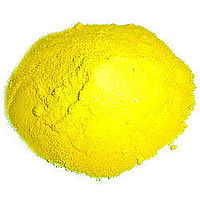 Anhydrous calcium chromate
| |
 Calcium chromate pigment
| |
| Names | |
|---|---|
| IUPAC name
Calcium chromate
| |
| Other names
Calcium chromate (VI)
Calcium monochromate Calcium Chrome Yellow C. I. Pigment Yellow 33 Gelbin Yellow Ultramarine | |
| Identifiers | |
3D model (JSmol)
|
|
| ChemSpider | |
| ECHA InfoCard | 100.033.955 |
| EC Number |
|
PubChem CID
|
|
| RTECS number |
|
| UNII | |
CompTox Dashboard (EPA)
|
|
| |
| |
| Properties | |
| CaCrO4 | |
| Molar mass | 156.072 g/mol |
| Appearance | bright yellow powder |
| Density | 3.12 g/cm3 |
| Melting point | 2,710 °C (4,910 °F; 2,980 K) |
| anhydrous 4.5 g/100 mL (0 °C) 2.25 g/100 mL (20 °C) dihydrate 16.3 g/100mL (20 °C) 18.2 g/100mL (40 °C) | |
| Solubility | soluble in acid practically insoluble in alcohol |
| Structure | |
| monoclinic | |
| Related compounds | |
Other anions
|
Calcium dichromate |
Other cations
|
Beryllium chromate Magnesium chromate Strontium chromate Barium chromate Radium chromate |
| Hazards | |
| Occupational safety and health (OHS/OSH): | |
Main hazards
|
highly toxic, carcinogen, mutagen |
| NFPA 704 (fire diamond) | |
Except where otherwise noted, data are given for materials in their standard state (at 25 °C [77 °F], 100 kPa).
| |
Calcium chromate is an inorganic compound with the formula CaCrO4, i.e. the chromate salt of calcium. It is a bright yellow solid which is normally found in the dihydrate form CaCrO4·2H2O. A very rare anhydrous mineral form exists in nature, which is known as chromatite.[1]
The compound is occasionally used as a pigment, but this usage is limited due to the very toxic and carcinogenic nature of hexavalent chromium compounds such as chromate salts.
